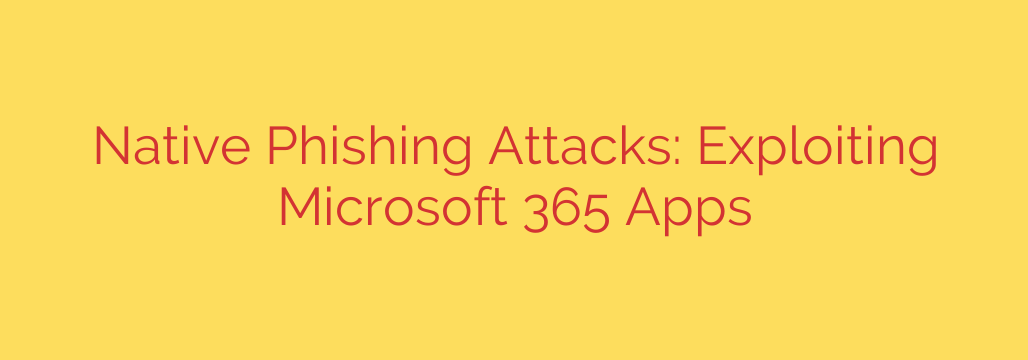
The Hidden Threat in Your Inbox: How Attackers Use Microsoft 365 Against You
You receive an email from a partner or colleague with a link to a SharePoint file or a request to fill out a Microsoft Form. The URL looks legitimate—it’s hosted on sharepoint.com or forms.office.com. Your browser shows the familiar Microsoft login screen, or maybe you’re already logged in. It seems completely safe.
This is the perfect setup for one of today’s most deceptive and effective cyberattacks: native phishing. Instead of using fake websites, attackers are now exploiting the very tools you trust, turning Microsoft 365’s legitimate features into weapons for credential theft and malware distribution.
What is Native Phishing?
Traditional phishing attacks rely on creating fake login pages on suspicious domains. Savvy users and email security systems have gotten better at spotting these. Native phishing, however, is far more sophisticated.
A native phishing attack uses the legitimate infrastructure of a cloud service to host and deliver malicious content. Attackers leverage trusted platforms like OneDrive, SharePoint, and Microsoft Forms to build their traps. Because the phishing links originate from official Microsoft domains, they are inherently trusted by both users and security systems.
The core of the problem is that the attack is hosted on a trusted service. Your email security gateway sees a link to SharePoint and lets it through because SharePoint is a legitimate, widely used business application. This allows the threat to land directly in your employee’s inbox, bypassing traditional defenses.
Why Standard Security Tools Are Failing
Your organization’s security stack is designed to identify known threats. It blocks emails from bad domains, quarantines attachments with malware signatures, and flags suspicious links. However, native phishing neatly sidesteps these measures:
- Trusted Domains: The link isn’t to
micosoft-login.scam.combut to an actual Microsoft domain. Security filters have no reason to block it. - Encrypted Traffic: All traffic to Microsoft 365 services is encrypted (HTTPS), preventing network security tools from inspecting the content of the page.
- Benign Links: The initial link in the email often points to a harmless “bridge” page, like a legitimate but compromised SharePoint site. The malicious payload is one or two clicks away, a tactic designed to evade automated sandboxing tools that only perform a shallow analysis.
As a result, these attacks have an incredibly high success rate. Users have been trained to check the URL, but in this case, the URL is genuine. The familiarity and trust associated with the Microsoft brand lull them into a false sense of security.
Common Attack Vectors in Microsoft 365
Attackers have become creative in using Microsoft’s own tools for their campaigns. Here are some of the most common methods:
- Microsoft Forms for Credential Harvesting: An attacker can easily create a Microsoft Form that perfectly mimics a login page, a survey asking for personal information, or a password reset prompt. They then share the link, and any data entered by the victim is sent directly to the attacker.
- SharePoint and OneDrive for Malware Delivery: A favorite tactic is to upload a malicious file (like a PDF or Word document containing malware) to a OneDrive or SharePoint account. They then use the built-in “Share” feature to generate a link and email it to their targets. The victim clicks the link, sees a familiar file-sharing interface, and downloads the infected file.
- OneNote as a Malicious Container: Attackers are increasingly using OneNote files as Trojan horses. They can embed malicious scripts or links within a OneNote document, which, when opened, can execute malware or direct the user to a phishing site.
How to Protect Your Organization: Actionable Security Tips
Defending against native phishing requires a multi-layered approach that goes beyond technology. It demands a combination of smarter tools, stricter policies, and, most importantly, user vigilance.
Prioritize Advanced User Training: Your employees are the last line of defense. Train them to be suspicious of any unexpected request, even if it comes from a trusted service. The key question should always be: “Was I expecting to receive this file or this request from this person?” Encourage them to verify unexpected sharing notifications through a separate communication channel (like a phone call or a new email).
Enforce Multi-Factor Authentication (MFA): This is the single most effective step you can take. Even if an attacker successfully steals a user’s password through a native phishing form, MFA prevents them from using those credentials to access the account. Make MFA mandatory for all users, without exception.
Harden Your Microsoft 365 Tenant: Review and tighten your sharing policies. Where possible, disable or restrict anonymous and public sharing links. Configure external sharing settings to only allow collaboration with specific, trusted domains. Limiting the attack surface is a critical proactive step.
Deploy Modern Email Security: Relying on basic email filtering is no longer enough. You need an advanced email security solution that uses AI and machine learning to analyze the context and content of emails, not just the reputation of links. These tools are better equipped to identify the subtle anomalies that signal a native phishing attempt.
Foster a Culture of Reporting: Make it easy for users to report suspicious emails. A simple “Report Phishing” button in their email client can provide your security team with invaluable, real-time threat intelligence. When users feel empowered to report threats without fear of blame, the entire organization becomes more secure.
Ultimately, the rise of native phishing is a reminder that cyber threats are constantly evolving. As we place more trust in cloud platforms, attackers will continue to find new ways to exploit that trust. By combining robust technical controls with a well-informed and cautious workforce, you can effectively defend your organization against this hidden threat.
Source: https://www.bleepingcomputer.com/news/security/the-rise-of-native-phishing-microsoft-365-apps-abused-in-attacks/








